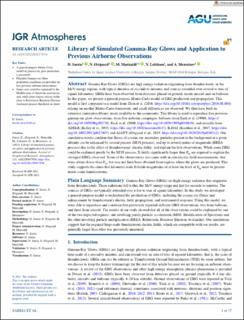| dc.description.abstract | Gamma-Ray Glows (GRGs) are high energy radiation originating from thunderclouds, in the MeV energy regime, with typical duration of seconds to minutes, and sources extended over several to tens of square kilometers. GRGs have been observed from detectors placed on ground, inside aircraft and on balloons. In this paper, we present a general purpose Monte-Carlo model of GRG production and propagation. This model is first compared to a model from Zhou et al. (2016, https://doi.org/10.1016/j.astropartphys.2016.08.004) relying on another Monte-Carlo framework, and small differences are observed. We then have built an extensive simulation library, made available to the community. This library is used to reproduce five previous gamma-ray glow observations, from five airborne campaigns: balloons from Eack et al. (1996b, https://doi.org/10.1029/96gl02570), Eack et al. (2000, https://doi.org/10.1029/1999gl010849); and aircrafts from ADELE (Kelley et al., 2015, https://doi.org/10.1038/ncomms8845), ILDAS (Kochkin et al., 2017, https://doi.org/10.1002/2017jd027405) and ALOFT (Østgaard et al., 2019, https://doi.org/10.1029/2019jd030312). Our simulation results confirm that fluxes of cosmic-ray secondary particles present in the background at a given altitude can be enhanced by several percent (MOS process), and up to several orders of magnitude (RREA process) due to the effect of thunderstorms' electric fields, and explain the five observations. While some GRG could be explained purely by the MOS process, E-fields significantly larger than Eth are required to explain the strongest GRGs observed. Some of the observations also came with in-situ electric field measurements, that were always lower than Eth, but may not have been obtained from regions where the glows are produced. This study supports the claim that kilometer-scale E-fields magnitudes of at least the level of Eth must be present inside some thunderstorms. | en_US |

